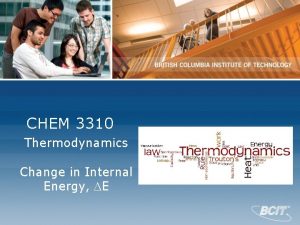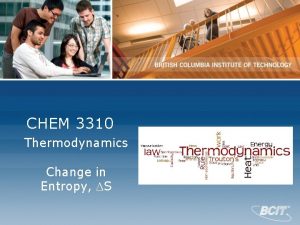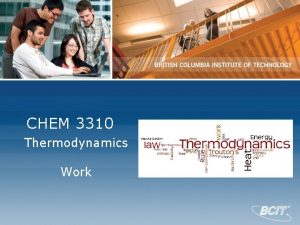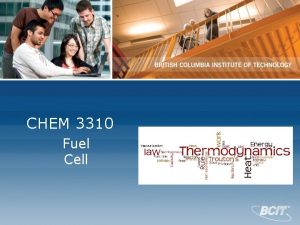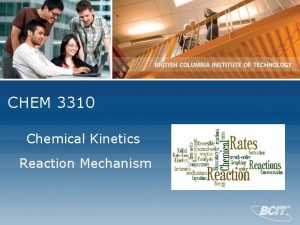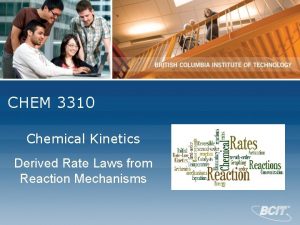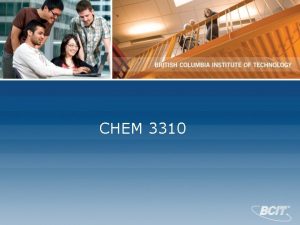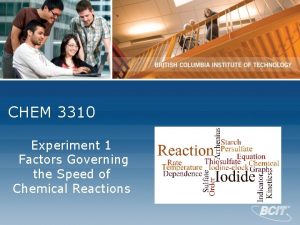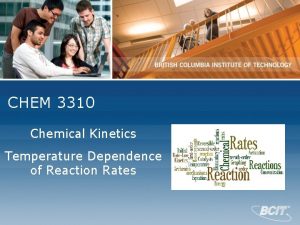CHEM 3310 Thermodynamics CHEM 3310 2 Thermodynamics The
































- Slides: 32

CHEM 3310 Thermodynamics

CHEM 3310 2

Thermodynamics • The study of energy changes accompanying physical and chemical processes. • From the laws of thermodynamics, one can: 1. Predict the results of chemical reactions 2. Ascertain whether or not a reaction is possible 3. Predict quantitatively the effect of changes in the experimental conditions CHEM 3310 3

What is Energy? 1. Kinetic Energy (KE) – the energy of motion due to the motion of the system's particles (translations, rotations, vibrations) 2. Potential Energy (PE) – the stored energy in an object by virtue of its position or composition (chemical bonds, electric energy of the atoms within the molecules) Energy cannot be created nor destroyed. The total energy of the universe is a constant. Energy can, however, be converted from one form to another or transferred. CHEM 3310 4

Terminology: System is the portion of the physical world that is selected for a thermodynamic study. Examples: System • A beaker of water • A polluted lake Surroundings is the portion of the universe with which the system interacts. Isolated System = System + Surroundings The total energy in any isolated system is constant. CHEM 3310 5

Internal Energy, E • All substance possess internal energy, because the molecules of all substances all have kinetic energy and potential energy. • • Internal energy, represented by E, is essentially thermal energy of the particles making up the system (all the atoms or molecules of the body due to their random motion and position). It is the sum of the kinetic and potential energies of the particles that form the system. E = KE + PE CHEM 3310 6

Internal Energy, E E = KE + PE In an ideal gas the molecules are so far apart that intermolecular forces can be ignored. Therefore, there is no potential energy. So all the energy is kinetic. • The simplest system is an ideal gas. • Kinetic Molecular Theory assumes that the temperature of a gas is directly proportional to the average kinetic energy of its particles. At T 1 At T 2 T 1 < T 2 • The internal energy of an ideal monatomic gas is therefore directly proportional to the temperature of the gas. E = 3/ CHEM 3310 2 n. RT R = gas constant T = temperature in Kelvin 7

Internal Energy, E Calculate the internal energy of a pressurized bottle of Helium gas with volume 0. 0498 m 3 at 1. 01 x 107 Pa. You can use the gas law PV=n. RT to express the internal energy in terms of pressure and volume: 0. 368 m x 0. 368 m = 0. 0498 m 3 E = 3/2 n. RT = 3/2 PV = 3/2 (1. 01 x 107 Pa)(0. 0498 m³) = 7. 54 x 105 Pa m³ = 7. 54 x 105 J (1 atm = 101. 325 k. Pa) CHEM 3310 8

Internal Energy, E The internal energy of other systems that are more complex than the ideal gas are harder to measure. But the internal energy of the system is still has a unique value for each temperature. E = f(T) Where f is monotonically increasing function. As the temperature of the system increases, the internal energy of the system also increases. CHEM 3310 9

Temperature, T Use a thermometer to measure a beaker of water at room temperature. T = 21. 5 °C This measurement describes the state of the system at a particular moment in time. It doesn’t tell us how the water got to room temperature. Temperature is a state function. CHEM 3310 10

Internal Energy, E Because the internal energy of the system has a fixed value for any temperature, internal energy is also a state function. (E depends on the state of the system in terms of P, V and T. ) Any change in the internal energy of the system is equal to the difference between its initial and final values. Esystem = Efinal - Einitial CHEM 3310 11

The First Law of Thermodynamics The total energy of the universe is constant. Energy can be transferred from the system to its surroundings and vice versa, but it cannot be created nor destroyed. The energy lost by the system is gained by the surroundings such that - Esystem = Esurroundings Euniverse = Esystem + Esurroundings = 0 System CHEM 3310 Surroundings 12

There are two ways to change the internal energy of a system: 1. By flow of heat, q Heat is the transfer of thermal energy between the system and the surroundings 2. By doing work, w Work can be converted into heat and vice versa. q and w are process dependent, and are not state functions. CHEM 3310 13

Units of Energy Calorie: One calorie is defined as the amount of heat required to raise the temperature of 1 g of water by 1 degree celsius. Joule: One joule is the work done when a force of one Newton is used to move an object one meter. 1 J = 1 N m Conversion: 1 calorie = 4. 184 joules CHEM 3310 14

Heat, q • • • A form of energy Passes from one body to another as a result of a difference in temperature Heat flows from a higher temperature to a lower temperature Heat cannot be measured, but the effects which it produces is measurable. CHEM 3310 15

Measurement of the Effects of Heat • • The measurements of heat effects is known as calorimetry. The instrument used is the calorimeter. System : the molecules inside the reaction chamber Surroundings : the container holding the sample and the water bath Isolated System : the calorimeter The condition under which the measurement is made is constant volume. This is a schematic of a bomb calorimeter CHEM 3310 16

Experiment 8 – Measure E of a combustion reaction Parr Bomb

Experiment 8 – Measure E of a combustion reaction Combustion of Cyclohexanol

Measurement of the Effects of Heat In the isolated system containing Substance A q n. A T where n. A is the number of moles of substance A T = T 2 – T 1 (T 2 = final temperature, T 1 = initial temperature) Introduce a proportionality constant, CA, such that q = n. ACA T CA is the molar heat capacity; it is characteristic of the substance. CHEM 3310 19

Molar Heat Capacity is the quantity of heat necessary to raise the temperature of one mole of the material by one degree Celsius. Specific Heat is the quantity of heat necessary to raise the temperature of one gram of the material by one degree Celsius. q = m. Ac. A T where m. A is the mass of substance A T = T 2 – T 1 c. A is the specific heat of substance A CHEM 3310 20

Units of Heat Calorie: One calorie is defined as the amount of heat required to raise the temperature of 1 g of water by 1 degree Celsius. Specific heat of water = 1. 00 cal g-1 °C-1 Molar heat of water = 18. 0 cal mole-1 °C-1 Conversion: 1 calorie = 4. 184 joules Specific heat of water = 4. 18 J g-1 °C-1 CHEM 3310 21

Heat Capacity • varies as a function of temperature CA @ 100 K is not the same as CA @ 300 K • is different if the heating is done under constant pressure or under constant volume conditions • Heat capacity measured under constant pressure is Cp Heat capacity measured under constant volume is Cv • For liquids and solids, there is little difference between Cp and Cv. • For gas, Cp > Cv. CHEM 3310 22

Sign Convention The internal energy and temperature of a system increase (E > 0) when the system gains heat from its surroundings. The internal energy and temperature of a system decrease(E < 0) when the system loses heat to its surroundings. • q > 0 when heat is added to the substance • q < 0 when heat is lost by the substance • q > 0 when T 2 > T 1 (i. e. T>0) • q < 0 when T 2 < T 1 (i. e. T<0) CHEM 3310 23

Example: 100. 0 g of Pb heated to 100 °C is dropped into 10. 00 g of water at 0 o. C. What is the final temperature? Assume that heat transfer is between the two substances. Specific heat, Cp, of Pb is 0. 0308 cal g-1 °C-1 Specific heat, Cp, of water is 1. 00 cal g-1 °C-1 Answer: • Heat lost by the Pb = Heat gained by the water • - q. Pb= qwater • - m. Pb c. Pb (T 2 -T 1)Pb= mwater cwater (T 2 -T 1)water T 2 = ? T 1 = 100 °C CHEM 3310 T 2 = ? T 1 = 0 °C T 2 = 23. 6 °C 24

Latent Heat Effects • The heat effects associated with changes in physical state such as fusion and vapourization are known as latent heat effects. • Heat of Fusion - the heat required to melt a substance at its normal melting temperature - the energy required to reorganize the intermolecular structure of a substance. Let’s heat up 1 g of water! CHEM 3310 25

Latent Heat Effects • Heat of Vaporization – the heat required to vaporize a substance at its normal boiling temperature Heat of fusion of ice is 79. 71 cal/g at 0 o. C and 1 atm. Heat of vaporization of water is 539. 6 cal/g 100 o. C and 1 atm. CHEM 3310 26

Sign Convention The internal energy and temperature of a system decrease (E < 0) when the system loses heat. The internal energy and temperature increase (E > 0) when the system gains heat from its surroundings. HEAT System loses heat System E < 0, q < 0 E > 0, q > 0 System gains heat Surroundings CHEM 3310 27

Calculation : Example 1: A 1. 00 g sample of the rocket fuel hydrazine, N 2 H 4, is burned in a bomb calorimeter containing 1200. g of water. The temperature rises From 24. 62 °C to 27. 96 °C. Taking the heat capacity of the calorimeter to be 200. cal °C-1, calculate: (a) q for the combustion of the 1 g sample (b) The molar heat of combustion of hydrazine. Answer: (a) -4680 calories (b) -150. kcal/mole

Calculation: Example 2: When 5. 00 g of sodium hydroxide is added to 100. g of water, the temperature rises from 25. 0 o. C to 37. 5 °C. Calculate the molar heat of reaction for the process Na. OH (s) Na+ (aq) + OH- (aq) taking the specific heat of water to be 1. 00 cal g-1 °C-1 and that of Na. OH to be 0. 48 cal g-1 °C-1. Answer: -10. 2 kcal/mole

Calculation: Example 3: An experiment is designed to measure the heat of fusion of ice. 25 g of ice at 0 °C was dropped into 195 g of water at 30 °C. The water is contained in a copper calorimeter of mass 100 g. The final temperature was 18 °C. Given the specific heat of copper is 0. 093 cal g-1 °C-1, find the heat of fusion of ice. Answer: Heat of fusion of ice = 80. 1 cal/g

Calculation: Example 4: Steam at 100. °C is condensed in a large calorimeter. The heat capacity of the calorimeter is expressed as “water equivalent” to 272 g. The calorimeter contains 2. 82 kg of water at 5. 0 °C. The final temperature of 27. 8 °C is reached after 115 g of steam has been condensed. Find the latent heat of vaporization of water as given by these data. Answer: Heat of vaporization of water = 540 cal/g

Next we will talk about work! HEAT WORK Work is done by the system E < 0, q < 0 E > 0, q > 0 System loses heat System Work is done on the system E < 0, q < 0 E > 0, q > 0 System gains heat Surroundings CHEM 3310 32
 Fin 3310
Fin 3310 3310
3310 District 3310
District 3310 Ns 3310
Ns 3310 Rfc 3310
Rfc 3310 Thể thơ truyền thống
Thể thơ truyền thống Chúa yêu trần thế alleluia
Chúa yêu trần thế alleluia Từ ngữ thể hiện lòng nhân hậu
Từ ngữ thể hiện lòng nhân hậu Hổ sinh sản vào mùa nào
Hổ sinh sản vào mùa nào Diễn thế sinh thái là
Diễn thế sinh thái là Vẽ hình chiếu vuông góc của vật thể sau
Vẽ hình chiếu vuông góc của vật thể sau 101012 bằng
101012 bằng Tỉ lệ cơ thể trẻ em
Tỉ lệ cơ thể trẻ em Lời thề hippocrates
Lời thề hippocrates Vẽ hình chiếu đứng bằng cạnh của vật thể
Vẽ hình chiếu đứng bằng cạnh của vật thể đại từ thay thế
đại từ thay thế Quá trình desamine hóa có thể tạo ra
Quá trình desamine hóa có thể tạo ra Công thức tính thế năng
Công thức tính thế năng Môn thể thao bắt đầu bằng chữ đua
Môn thể thao bắt đầu bằng chữ đua Khi nào hổ mẹ dạy hổ con săn mồi
Khi nào hổ mẹ dạy hổ con săn mồi Thế nào là mạng điện lắp đặt kiểu nổi
Thế nào là mạng điện lắp đặt kiểu nổi Hát kết hợp bộ gõ cơ thể
Hát kết hợp bộ gõ cơ thể Dot
Dot Nguyên nhân của sự mỏi cơ sinh 8
Nguyên nhân của sự mỏi cơ sinh 8 Phản ứng thế ankan
Phản ứng thế ankan Chó sói
Chó sói Thiếu nhi thế giới liên hoan
Thiếu nhi thế giới liên hoan điện thế nghỉ
điện thế nghỉ Một số thể thơ truyền thống
Một số thể thơ truyền thống Trời xanh đây là của chúng ta thể thơ
Trời xanh đây là của chúng ta thể thơ Thế nào là hệ số cao nhất
Thế nào là hệ số cao nhất Hệ hô hấp
Hệ hô hấp Ng-html
Ng-html




































